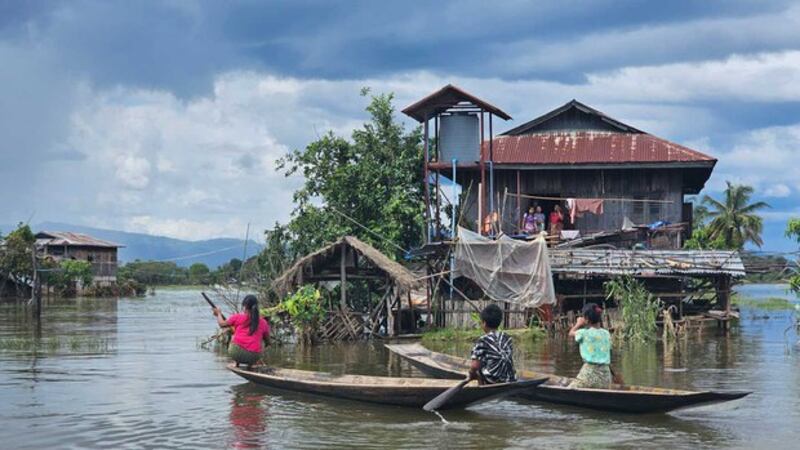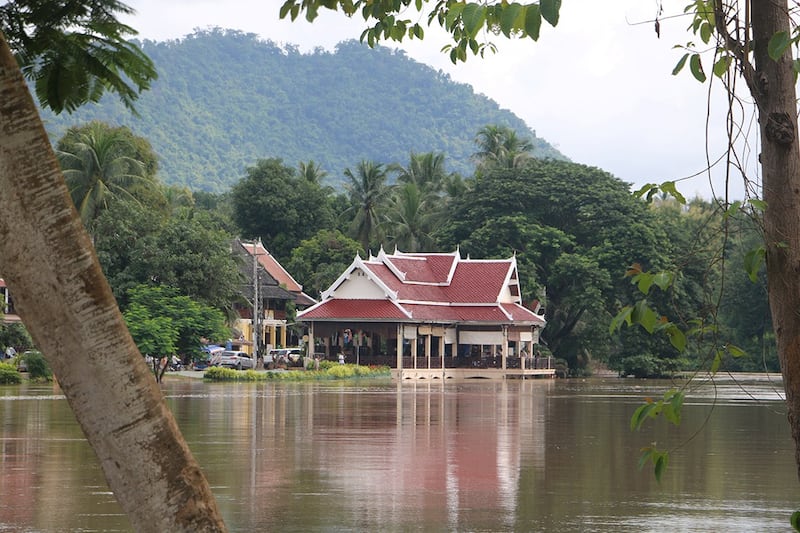Myanmar’s military junta has delivered almost no relief aid and done little else to help people affected by Typhoon Yagi, which caused widespread flooding in central and eastern parts of the country, several people told Radio Free Asia.
In neighboring Laos, where Asia’s worst storm of the year also caused flooding, there are similar complaints of an insufficient government response.
“There is one group that came to help – not the government,” a resident of Na Leev village in northern Houaphanh province told RFA. “They helped with food and blankets. But for shelter, we had to do that by ourselves.”
In Myanmar, Typhoon Yagi damaged schools and tens of thousands of homes in Shan and Kayah states and the Mandalay region. The U.N. Office for the Coordination of Humanitarian Affairs said that the flooding had affected more than 1 million people in 70 towns across the country.
Some villages near rivers remain under water one month after the storm, while no work has been done on damaged roads that have left some residents unable to travel to neighboring villages, Mandalay residents said.
A resident of Kayah state’s capital, Loikaw, told RFA that 10 neighborhoods in the town were severely affected by flooding. People who live on the outskirts of Loikaw have received no food or other aid deliveries, he said, requesting anonymity for security reasons.
“We received relief food items, but those farther out did not,” he said. “The aid group mainly reached the town’s main religious community hall. Some residents are taking shelters at the monasteries and some religious buildings.”
A relief worker in Kayah state told RFA last month that their team had to turn back when junta forces in Loikaw prevented them from accessing flood-affected areas.
The junta has restricted the delivery of relief items elsewhere under the pretext that they are going to rebel groups.
RFA was unable to reach junta spokesperson Major General Zaw Min Tun to ask about the absence of relief aid in flood-affected areas.
Businesses in various regions and states have announced cash contributions for aid relief. In Shan state alone, the junta has received more than 1 billion kyat (US$476,000) in donations, according to media reports.
Junta officials haven’t announced how the money is being used. But media outlets controlled by the junta have reported on visits by top ministers to flood-affected areas where they provided assistance.
Manpower and machines needed
Residents of Mandalay’s Myittha township have spent the last few weeks clearing their streets of debris and rehabilitating their homes, resident Kyi Kyi Than told RFA.
“We have to do cleaning work. No one helped us,” he said. “We are depending on the food items previously delivered. We have no other options.”
Several weeks ago, each flood-affected person in the township received 2,000 kyat (US$0.95) from village administrators. Residents have used some of that money to hire daily wage laborers to help clean the flood debris, he said.

Social relief groups have been helping with cleaning houses and repairing the roads in several towns in southern Shan state, a volunteer told RFA.
“At present, we are stationed in Nyaung Shwe township to provide relief aid, such as food, charcoal sticks and stoves,” he said. “We have also helped in removing muds. But we need more manpower and machines to clean so many houses.”
In Kalaw, a former British hill station that continues to be a tourist attraction, about 3,000 houses in four neighborhoods were damaged by flooding, along with markets, schools and hospitals in the town, local residents said.
About 100 people died from the flood in Kalaw, and more than 100 remain missing, residents said. Nearly 2,000 houses flooded in the Inlay area, which is adjacent to Kalaw.
Slow response in Laos
In Laos, torrential rain on Sept. 21 and Sept. 22 caused flooding on top of the damage to homes, rice fields and roads from the earlier storm, residents said.
Three districts in Luang Namtha province had widespread damage from the typhoon’s heavy rains and flooding. But no government aid has been forthcoming, one villager told RFA.
“We haven’t had any help at all,” she said, adding that her family has moved in with her husband’s family in another village. “After the water dries, we will go back.”

An official from the natural disaster unit in one northern province, who wished to remain anonymous for security reasons, told RFA that the government has to rely on donations from international organizations because of the government’s budget constraints.
“They have some money, but they spent it on the last flood disaster,” he said.
He added that the flood arrived unexpectedly, leaving the national government and local officials with insufficient time to prepare to help affected villagers.
An official with a foreign organization that aids those affected by floods in Laos told RFA that the government spends excessive time assessing damage rather than immediately assisting villagers. Most aid over the last few weeks has come from the public, she said.
Translated by Aung Naing and Sidney Khoypanya. Edited by Matt Reed. RFA Lao contributed to this report.
